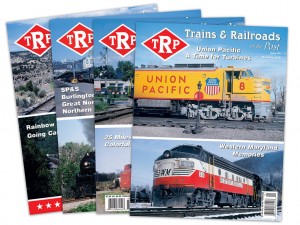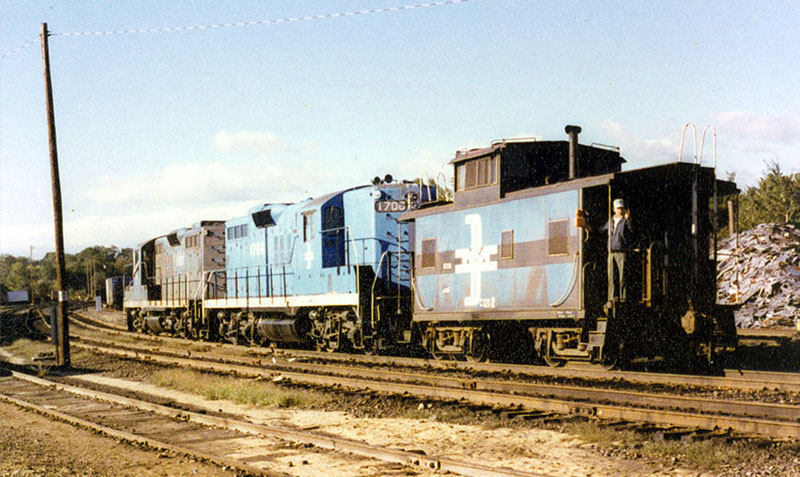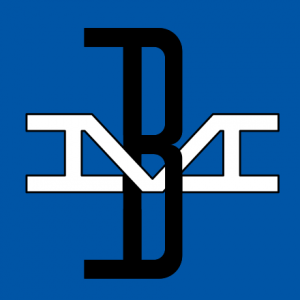 By Barry Sanel/photos by the author
By Barry Sanel/photos by the author
As long as I can remember, I have always been very enthusiastic about trains. My first finger painting was of a locomotive. I bugged my parents to take me to most of the eastern railroad museums including Steamtown when it was located in Bellows Falls, Vermont. We also visited the railroad at Clark’s Trading Post in Lincoln, N.H., and the old Edaville Railroad in South Carver, Mass. I thought that maybe someday I would work for the railroad and become an engineer.
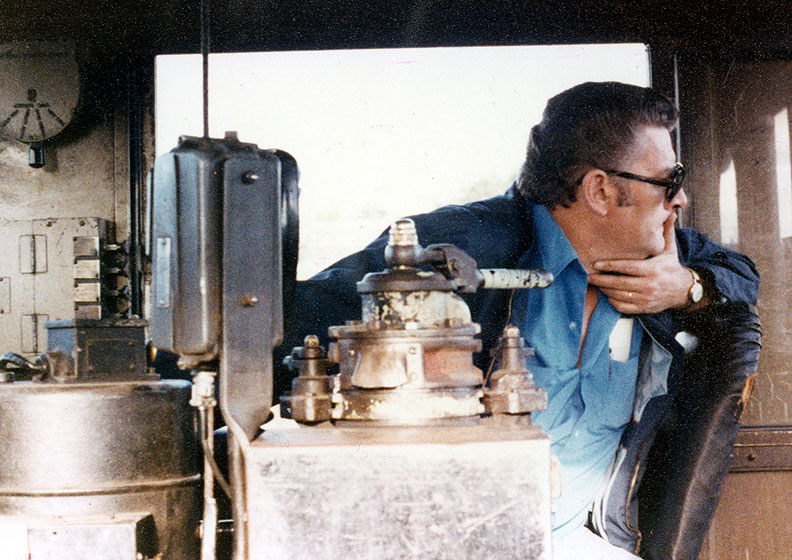
My teacher this day was Aubrey Stuart Adair Sr., whom everyone called “Stoody.”
Our family business was Sanel Auto Parts in Manchester, N.H., founded by my grandfather and later operated by my dad. Bob Adair worked for my dad and knew I liked trains. His dad Aubrey Stuart Adair, Sr. (his nickname was “Stoody”) worked for the Boston & Maine. Somehow my dad arranged for me to spend a Saturday working in Manchester Yard with Stoody. There was also the possibility I could ride a road freight round trip to Boston. I was almost thirteen years old then, and it’s been more than twenty-five years since this event took place and some of the details of that day are a little foggy.
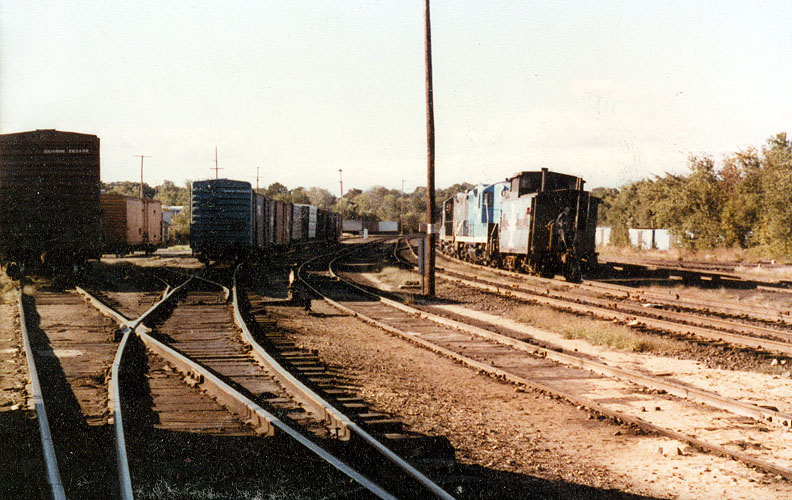
The Boston & Maine freight yard at Manchester, N.H., October 1977. I got up very early to go to work with the yard crew on this day.
The freight yard was located on the southern end of Elm and Canal Streets in Manchester, just south of all of the Amoskeag Mills behind Noyes Tires. You can see the area from Route 3 across the river. I don’t know if any of this still exists, but there is a football field close by that location now.
On a Saturday just before my thirteenth birthday in October 1977, I got up very early and my dad drove me to the yard. When we got there, Stoody brought me into the yard office. I don’t remember much about the old building except that the workers’ lockers were upstairs and that it was very dirty inside. I clearly recall them scurrying about to remove all of the Playboy magazines they had lying around. I also recall getting a kick out of the fact that the old grizzled rail workers were trying really hard not to swear around me. Everyone treated me very nicely, and I appreciated it. Looking back, I suspect that they didn’t have too many kids visit them on the job.
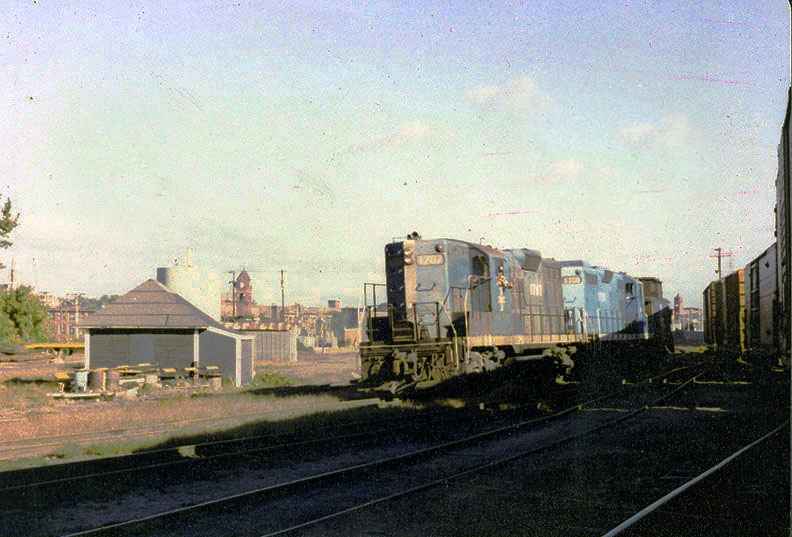
The Boston road freight departing Manchester Yard, you can see some of the city in the distance.
At this point I was waiting to find out about our trip to Boston. I found out that the crew was leaving later in the morning, so there would have been no way for me to get back to Manchester at a reasonable hour. I also think that my dad probably wanted to pick me up in the afternoon, and not have to worry about fetching me in the middle of the night. I was especially disappointed because I could see the two GP9’s that would be making the trip were sitting in the yard idling when I got there. Instead of the trip to Boston, I was to ride along with Stoody and shuttle some freight around the yard and deliver some boxcars to local customers.
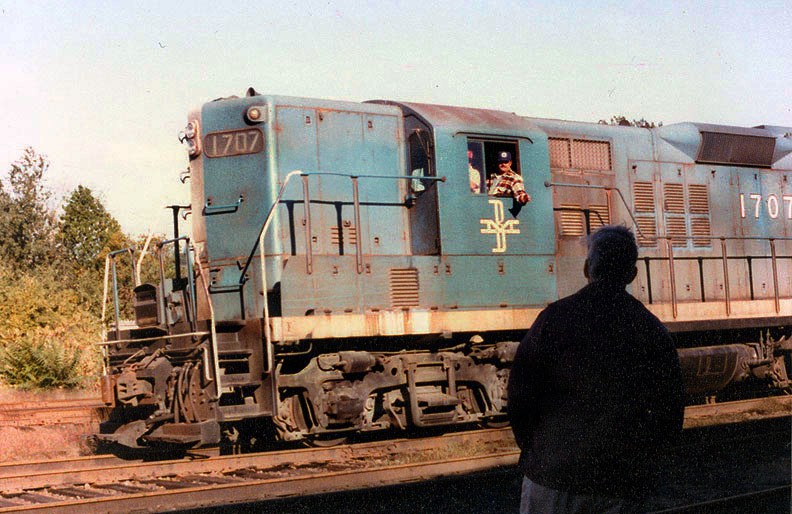
The Boston crew roars past the yard office at Manchester.
We had some time before we were supposed to leave, so Stoody and I walked around the yard for a while and took pictures. I got inside the weary SW-1 1122 (built 1953) for some photos. We were going to be using the 1208 (an NW-2 built 1949) which seemed to me to be in a whole lot better shape than the others.
Before we got going, another crew assembled their train and boarded the two GP9’s and left for Boston. I got a bunch of pictures of them leaving the yard. We all went outside and waved to the crew as they zoomed past us blowing their horn. It seemed to me like they were traveling about 60 miles per hour as they left the yard (though I’m sure it was far less). I was still bummed out about not being able to ride with them, but it was probably for the better.
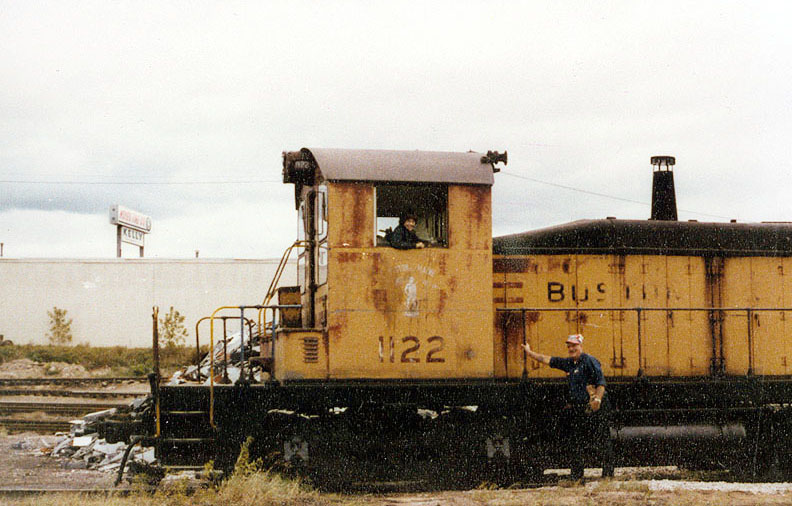
The paint was badly faded on B&M SW-1 1122, but it made for some great pictures. One of the crew has taken a picture of me inside the cab. This locomotive was later sold to Independent Locomotive Service and renumbered 1378. It is still in use today, working a contract switching operation in Superior, Wis.
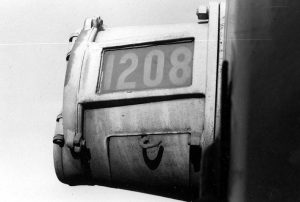 Up in the 1208, Stoody explained all of the relevant controls to me including the throttle, the brake, and the reverser. I learned that even if I shut off the throttle, momentum would carry the train until the brake was applied. I also learned that you had to feather the throttle; not enough and the train wouldn’t move, too much and the cars would jerk. I could see all the controls were really worn from the long hours of use. We also had a conductor/brakeman with us who would jump out of the engine and handle the switching and coupling duties. I thought it was cool how he was able to get on and off the locomotive while it was still moving!
Up in the 1208, Stoody explained all of the relevant controls to me including the throttle, the brake, and the reverser. I learned that even if I shut off the throttle, momentum would carry the train until the brake was applied. I also learned that you had to feather the throttle; not enough and the train wouldn’t move, too much and the cars would jerk. I could see all the controls were really worn from the long hours of use. We also had a conductor/brakeman with us who would jump out of the engine and handle the switching and coupling duties. I thought it was cool how he was able to get on and off the locomotive while it was still moving!
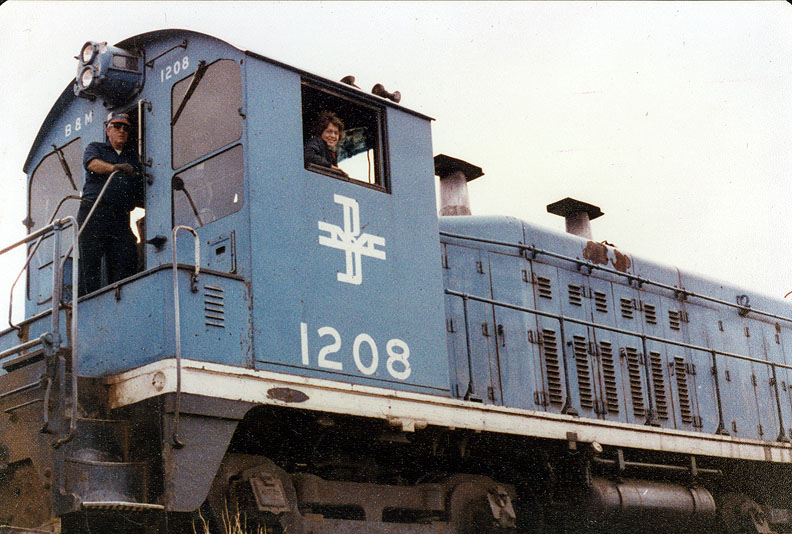
The 1208 would be our power for the morning’s work. Though I was disappointed I wasn’t riding to Boston, I was excited to be in the engineer’s seat of a real locomotive. Upon retirement in the 1980s, no. 1208 was scrapped.
I asked Stoody what the pedal on the floor with the large brick on it was for. He explained that in the occasionally engineers had heart attacks while the train was moving with obvious fatal results. It was called a “dead man’s pedal,” and if it was not depressed while the train was moving, a brake application would be made automatically. The brick placed on the pedal was a kind of work-around this feature, since there was so much movement involved in switching.
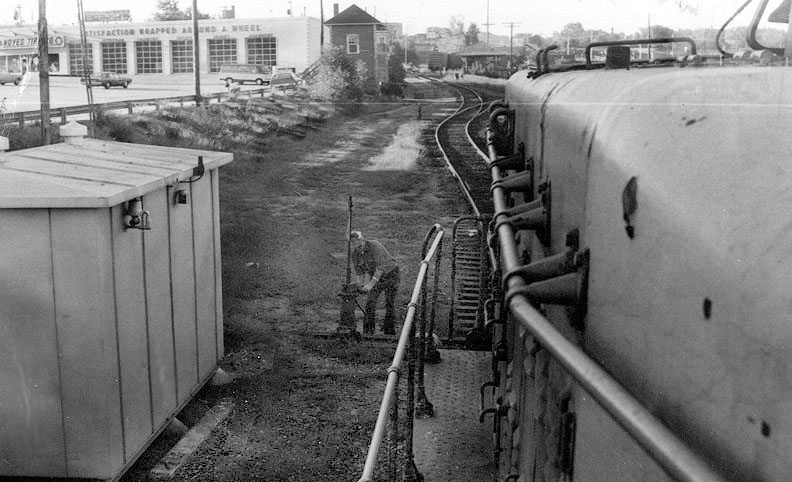
We coupled up to some cars and pushed them down the line. After I watched him for a while, Stoody asked me if I would like to pilot the locomotive by myself. I moved to the seat and tentatively put the selector into forward and throttled up and we actually started moving! I was running a locomotive! Once that rush was gone it occurred to me that it was pretty monotonous work because you didn’t actually have to steer. We rolled along a few miles past the Manchester airport to an industrial park.
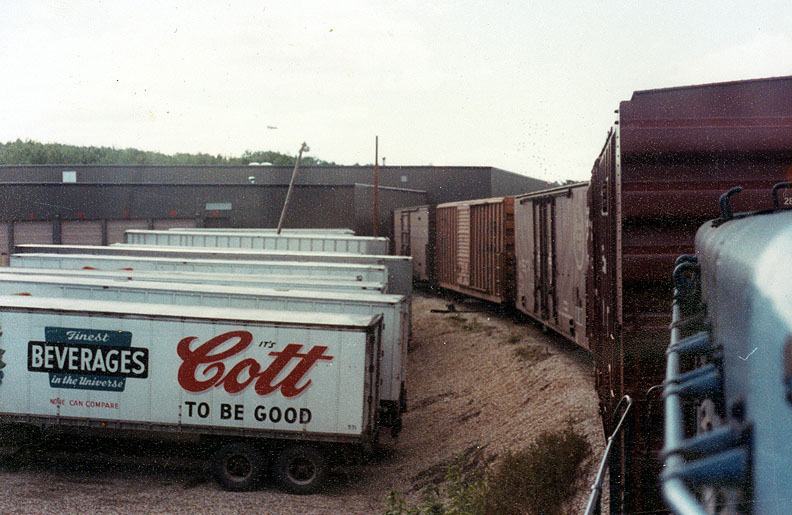
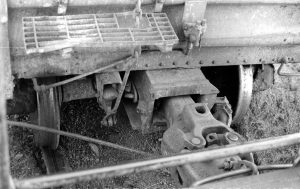 Stoody showed me how to make a good hitch. He demonstrated how to lightly apply the throttle so the cargo wouldn’t be jostled around too much. Maneuvering the throttle just enough, I made the connection, then jumped down and the brakeman helped me make the air hose connections. I was excited and I took a picture of my first hitch. I remember Stoody telling me that I did a good job. I also got to shove the cars into the Cott’s beverage warehouse taking hand signals from the men standing at the door. Looking back I can’t believe they let a 12-year-old do this (not to mention that the whole time I was busily snapping photos)!
Stoody showed me how to make a good hitch. He demonstrated how to lightly apply the throttle so the cargo wouldn’t be jostled around too much. Maneuvering the throttle just enough, I made the connection, then jumped down and the brakeman helped me make the air hose connections. I was excited and I took a picture of my first hitch. I remember Stoody telling me that I did a good job. I also got to shove the cars into the Cott’s beverage warehouse taking hand signals from the men standing at the door. Looking back I can’t believe they let a 12-year-old do this (not to mention that the whole time I was busily snapping photos)!
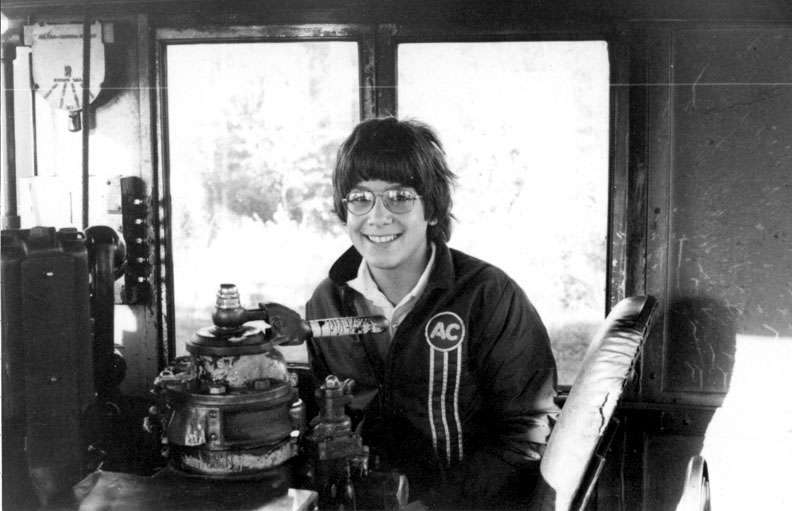
Once we switched Cott’s, I took some more pictures and we went back to the yard. The crew presented me with a dark blue baseball hat with a B&M patch on it. What a neat gift! I wore it non-stop for about three years until it was completely worn out. Stoody told me to come back whenever I wanted to, but unfortunately I never did.
I was really grateful to those men who took some time out of their day to share their railroading skills with me. Sadly, both the men, and most of the old B&M yard in Manchester are gone. While I took a different career path later in life, I still remember that day on the railroad fondly.
Barry Sanel works in the graphic arts printing industry for a major beverage producer in suburban New York.
Subscribe to
Trains & Railroads of the Past!